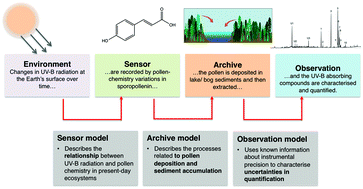Fossil pollen and spores as a tool for reconstructing ancient solar-ultraviolet irradiance received by plants: an assessment of prospects and challenges using proxy-system modelling
Abstract
Ultraviolet-B radiation (UV-B, 280–315 nm) constitutes less than 1% of the total solar radiation that reaches the Earth's surface but has a disproportional impact on biological and ecological processes from the individual to the ecosystem level. Absorption of UV-B by ozone is also one of the primary heat sources to the stratosphere, so variations in UV-B have important relationships to the Earth's radiation budget. Yet despite its importance for understanding atmospheric and ecological processes, there is limited understanding about the changes in UV-B radiation in the geological past. This is because systematic measurements of total ozone and surface UV-B only exist since the 1970s, so biological or geochemical proxies from sediment archives are needed to reconstruct UV-B irradiance received at the Earth surface beyond the experimental record. Recent developments have shown that the quantification of UV-B-absorbing compounds in pollen and spores have the potential to provide a continuous record of the solar-ultraviolet radiation received by plants. There is increasing interest in developing this proxy in palaeoclimatic and palaeoecological research. However, differences in interpretation exist between palaeoecologists, who are beginning to apply the proxy under various geological settings, and UV-B ecologists, who question whether a causal dose–response relationship of pollen and spore chemistry to UV-B irradiance has really been established. Here, we use a proxy-system modelling approach to systematically assess components of the pollen- and spore-based UV-B-irradiance proxy to ask how these differences can be resolved. We identify key unknowns and uncertainties in making inferences about past UV-B irradiance, from the pollen sensor, the sedimentary archive, and through the laboratory and experimental procedures in order to target priority areas of future work. We argue that an interdisciplinary approach, modifying methods used by plant ecologists studying contemporary responses to solar-UV-B radiation specifically to suit the needs of palaeoecological analyses, provides a way forward in developing the most reliable reconstructions for the UV-B irradiance received by plants across a range of timescales.

- This article is part of the themed collections: Plant responses to UV and 2019 Perspective article collection


 Please wait while we load your content...
Please wait while we load your content...